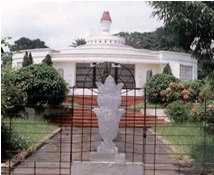 |
Parsi
Fire Temple, Jamshedpur Courtesy: www.Jamshedpurlive.com |
According to the Kissah-i-Sanjan—a chronicle written in the 17th century—in order to escape from religious persecution a group of Zoroastrians migrated to India from Persia after the fall of the Sassanian Empire in the 8th century CE. Eventually they were given refuge in Gujarat and five years later they built a temple to shelter the holy fire they had brought with them from Iran.
Over the years, in spite of the fact that Gujarati became their native language and they adopted many Indian customs, the Parsis have on the whole preserved their separate culture and religious identity. Worldwide there are now approximately 140,000 Parsis; in India they are concentrated around the area of Bombay. The numbers remain low because to become a Parsi one must be born of a Parsi father: one cannot be converted.
Most Parsis follow the Shenshai (‘royalist’) calendar. In the 18th century, when a Zoroastrian priest came from Iran to India to hold discussions with his Parsi counterparts, they discovered a one month difference between the Parsi and Iranian calendars. A group of priests subsequently decided to adopt the Iranian calendar, calling themselves Qadim, ‘the ancient ones’.*
On No Ruz (‘new day’) Parsi families wake up early, bathe and dress in new clothes. Homes are decorated Indian style with colourful rangoli patterns, often in the shape of a fish, considered to be particularly auspicious. Incense is lit and sandlewood powder is sprinkled on burning coals. Following a festive meal, the family visits the fire temple where Jashan—prayers of thanksgiving—are offered. In the evening, they visit friends or family sharing specially made sweets and exchanging greetings of “Sal Mubarak”, a wish for a prosperous year.
For information on the Fasli-based Jamshedi Noruz festival.